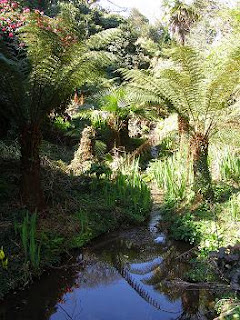Back to the monster mahonia again yesterday - I came to the conclusion that I'd see what happened after I'd done some restorative pruning (i.e. thinning out the very congested centre, removing crossing branches and so on).
Luckily that did take the height down a bit and what with a few judicious cuts which removed the remainder of the really tall bits, I managed to take about 5ft off the top without actually changing the shape of the tree much. I also had a lot of fun climbing about in the canopy - it doesn't take much to get me up clambering about in trees!
Result is a happy client - he got his view back - and happy me, having preserved a very special plant. I've revised my opinion of mahonias and will be recommending them as an unusual architectural plant to designers - but as 20ft trees, not the modest little specimens you see in most gardens.
One other thing - I have for my sins agreed to take over running the garden at my local primary school. Why is it we gardeners are such suckers for co-opting more things to grow and spaces to grow them in? Hopefully I can delegate a lot of the work to other parents - but I have to confess, I'm secretly quite excited about this little pond area they have there, which I plan to make into a fantastic little wildlife garden. Minibeast heaven. More later...
So long, and thanks for all the fish
-
I have had a simply lovely time over the half-dozen years or so since I
started this blog. Since July 2009, when I began by writing rather shyly
about sala...
10 years ago















